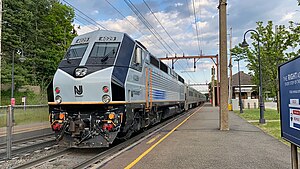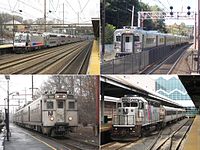Alstom PL42AC
This article needs additional citations for verification. (March 2009) |
| PL42AC | |||||||||||||||||||||||||||||||||
|---|---|---|---|---|---|---|---|---|---|---|---|---|---|---|---|---|---|---|---|---|---|---|---|---|---|---|---|---|---|---|---|---|---|
 New Jersey Transit PL42AC #4029 at Convent Station | |||||||||||||||||||||||||||||||||
| |||||||||||||||||||||||||||||||||
| |||||||||||||||||||||||||||||||||
| |||||||||||||||||||||||||||||||||
| |||||||||||||||||||||||||||||||||
| Sources:[2][4] except where noted | |||||||||||||||||||||||||||||||||
The Alstom PL42AC is a class of four axle B-B diesel-electric locomotive designed by Alstom in association with GM-EMD. 33 were built between 2003 and 2006 for NJ Transit Rail Operations.
Description
[edit]The PL42AC is a diesel-electric 4-axle locomotive built by Alstom with 16-710G3B prime mover for New Jersey Transit. The first two locomotives were manufactured at the Meinfesa plant in Valencia, Spain in 2003.[5] The 31 following units were assembled at the Alstom Transport plant in Hornell, New York in 2004,[6] and were produced through early 2006. The power rating of the PL42AC locomotives is 4,200 hp (3.1 MW) total for tractive effort and head-end power. The locomotive has a design similar to the GE Genesis, mainly due to the fact that both PL42AC and Genesis series locomotives were designed by industrial designer Cesar Vergara.[7]
This locomotive uses IGBT technology with precise traction computers for tractive effort. The PL42AC has 800 kilowatts head-end power and WABCO's EPIC II braking system, along with an E-7 wheel slide device, made by Wabtec, preventing flats spots on the wheels through software and hardware.
It has an Intelligent Display Unit (IDU) based on Bombardier Transportation technology from which an engineer or technician can view data or download events and faults from the previous weeks or months. The technician can do a host of tests from the IDU to determine if a specific system is operating correctly.
The PL42AC uses computer hardware and software to control functions and to protect the engine. For example, if the on-board computer detects too little oil in the system, it will shut down the engine to avoid damage.
Future
[edit]In July 2020, NJ Transit announced that older locomotives in the PL42AC fleet will be replaced by additional ALP-45A dual mode locomotives, due to the PL42AC's unreliability and inability to be upgraded to meet new Environmental Protection Agency standards.[8] Of the 33 units, 23 are slated for replacement, while the remaining 10 will receive a light overhaul for continued service.[9]
References
[edit]- ^ a b "Mainline Diesel-Electric Locomotives : PL42 AC" (PDF), www.vossloh-espana.com, archived from the original (PDF) on July 17, 2011, retrieved June 16, 2009
- ^ a b Vantuono, William C. (August 2002), "When form follows function – industrial design (p.2 of 3)", Railway Age
- ^ New Jersey Transit PL42-AC Locomotive Operating Instruction Manual.
- ^ "New locomotives for NJT", THE TRANSFER TABLE The Wilmington Chapter NRHS Official Newsletter Internet Edition, vol. 24, no. 7, Sep 2002
- ^ "Vossloh España Product References". Archived from the original on March 31, 2009. Retrieved March 23, 2009.
- ^ "After nearly four years of development, design, and construction, New Jersey Transit's 33 PL42AC diesel-electric locomotives have been completed and are expected to begin testing and certification on NJT lines soon". Railway Age. April 1, 2005.
- ^ "NJT PL42AC Locomotive". Vergara Studio. Retrieved January 28, 2019.
- ^ "NJ Transit to Purchase Eight Additional Dual-Powered Locomotives". NJ Transit (Press release). Archived from the original on August 3, 2020. Retrieved August 24, 2021.
- ^ NJ.com, Larry Higgs | NJ Advance Media for (2020-07-16). "NJ Transit buying $70M worth of new locomotives, approves $264M infusion from state". nj. Retrieved 2023-01-19.

